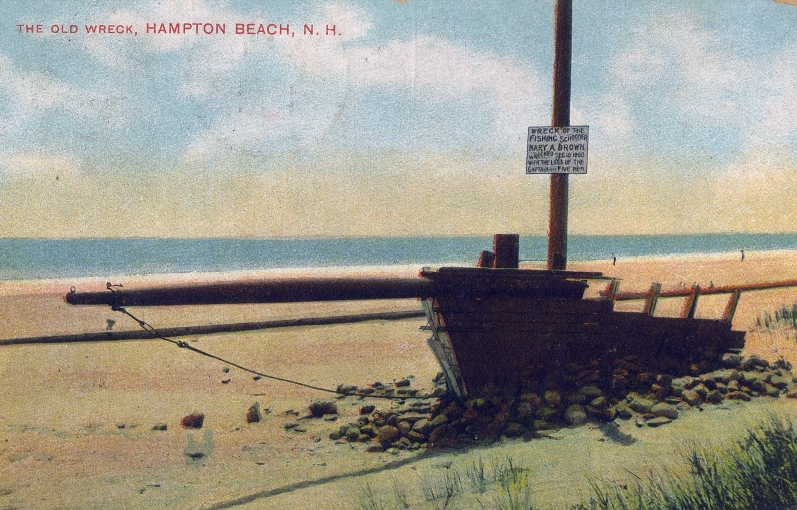December 7, 1900
(From “The Beachcomber” — July 16, 1976)
The little Gloucester fishing schooner “Mary A. Brown” was wrecked off Hampton Beach Tuesday night, doubtless with the loss of her entire crew of five men.

wrecked Dec 19, 1900 with the Loss of the Captain and Five Men
About 1 a.m. Wednesday, as Edward T. Merritt, of the life saving station, was patrolling the beach he saw a little below the street railway casino a fisherman’s trawl tub. On his way to Hampton river, he saw nothing more indicative of a wreck but on return, discovered the body of a man, just borne in by the waves. The man was clad in oil skins over his ordinary apparel and around his waist was a life belt, improved from the corks of a seine. He wore no boots. Mr. Merritt made a careful search for signs of life and then summoned aid from the station, whence in due time, the body was removed to the Field undertaking store in the village.
Coroner M. F. Smith viewed the remains, but deemed no inquest necessary. The news of the wreck early reached Gloucester and Joseph Gray, Walter Martin and Frank Riggs, of that city, came to Hampton and identified the remains as those of Arthur Eldredge, captain of the schooner. The vessel’s owner, Capt. John Mosetic, of Gloucester, spent Wednesday night in Hampton, and said that Captain Eldredge was a man of 38 years. He resided in Gloucester and left a widow.
Four men, all of Gloucester, composed the crew — Charles Green, aged 60, left a widow and three children; Thomas Sonier, 35 years, widow and two children; Charles Benson, 30 years, and Abe Pany, 60 years, cook. Nothing has been seen or heard of them since the wreck, but that all have perished there is practically no doubt. The life savers maintained the closest possible watch after the discovery of Captain Eldredge’s body.
The beach was soon strewn with wreckage, and the name of the unfortunate vessel was thus ascertained. She had left Gloucester Monday to trawl off Hampton, and it is conjectured was making for Portsmouth harbor Tuesday night, when she was dismasted, driven upon the Sunken rocks, and was quickly pounded to pieces. Her bows, to which clung a tangled mass of spars, rigging and sails, came ashore just below the Casino, and the boom half sawed off indicates that the vessel had been dismasted at sea, and that her crew had attempted to clear away the wreckage. Her clock was washed ashore and had stopped at 12:25.
The largest piece of wreckage was the greater part of the keel and one side of the vessel, which was dashed ashore a few hundred yards below the Casino. There were strewn along the beach, parts of the deck, the cabin top and a general debris of wreckage. Captain Smart and his life saving crew taking prompt care of all property of any value, pending the owner’s arrival.
The Mary A. Brown was a little schooner of 15 tons burden, 41.8 feet long, 13.6 feet broad, and 5.1 feet deep, and was built in 1876 in Bath, Me.
The wreck proved a strong magnet of attraction to the beach, and was inspected by hundreds. A special car ran between Hampton village and beach throughout Wednesday, and for the comfort of ladies, Superintendent McReel had one of the street railway cottages heated and opened.
It is worthy of record that Patrolman Merritt, who discovered Captain Eldredge’s body, was on his first night of duty. Henry Lattimer, one of the station crew, is sick with inflammatory rheumatism, and Mr. Merritt had been sent to take his place. His examination by Captain Smart elicited the fact that he had been in a life saving station but once before, two years ago, when he was rescued from a schooner wrecked on the southern coast.
[The wreckage of the Mary A. Brown remained on Hampton Beach for a decade, the subject of artists and postcard photographers.]